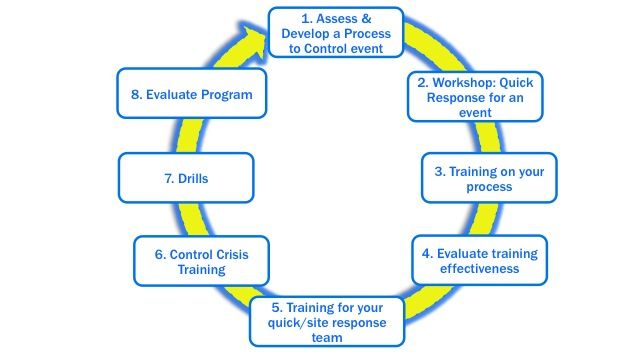Are you prepared for a major crisis at your company?
Often, companies are quick to say they are ready to respond to any crisis. When I ask to see a copy of their plan, there is usually a lengthy pause followed by a statement such as, “I will get you a copy.” For some reason, the copy never materializes.
When an incident occurs, many organizations are prepared with their accident investigation form to gather the facts on paper and submit the documentation within the required time up the chain of command. Some organizations use their local workers’ compensation forms to get the report into the system.
This kind of process is not a proactive and controlled response to a major event.
The level of importance of any crisis is measured by the size, scope and estimated costs. However, an event at a small company may be considered significant, while that particular event at a competitor may just be an everyday occurrence, and therefore not something to be concerned about.
We describe a “loss” as something that results in damage to property, loss of process or an injury. This gets covered well in standard incident reporting forms and procedures. A good definition of “crisis” is one from an article in Public Communication Review written by Gwyneth Howell and Rohan Miller: “A fluid, dynamic situation, that brings an organization into disrepute, and threatens its future profitability, growth and survival.”
It is prudent to shift our thinking on several fronts to effectively control a crisis situation.
Being proactive and responsive, and implementing a controlled plan immediately following a crisis can be advantageous and cost-effective for organizations. Having such a proactive and planned approach increases the affected company’s chances of quick recovery from the crisis.
What a company does after dealing with a crisis situation is also important. Every incident must be used as a learning opportunity. Taking the right corrective action following an incident minimizes or prevents the likelihood of the same incident re-occurring or another significant event from happening in the future.
Throughout my safety career, I have met with many business leaders, owners and team members after a tragic event has occurred on their watch. These events could be the loss of a part of production facility, an injury to a worker, and in some cases, a fatality.
After the dust had settled, I always ask the question: “What are you doing differently at this time, than when the tragic event occurred?”
Often, the response is, “We are not doing anything differently.”
When I ask them if they think a similar event could happen again, they usually reply, “Never though of that. Now that I think about it, yeah, it can happen again.”
Control the crisis
When a negative situation arises, the best approach for a company is crisis control. A “” response plan has three components:
Proactive and responsive approach. A formalized control program, training and defined responsibilities are most effective when they are proactive and responsive. This moves the company away from the debilitating reactive and victim position.
Resource allocation. Invest the time and resources to ensure that you develop a “control the crisis” response plan that mitigates the effect, reduces costs and quickly restores your company to its pre-event status.
Human factor. Ensure the human and personal factors that could engulf your team during a crisis are effectively addressed. This helps reduce their anxiety and fear at this crazy time.
The company specific “control the crisis” process is communicated, implemented and operationalized throughout the workplace. The diagram below provides a framework for initiating the incident response plan.
Consider some of these questions that may arise during a crisis.
• Who is responsible at the site to assist the individual that is hurt? Are those individuals well-equipped and able to effectively respond to a crisis?
• What type of assistance is available to the affected individuals? Is there an employee assistance program or other type of service in place?
• What information needs to be gathered and prepared when taking the affected individuals to the hospital? Are medical records, personal information and other pertinent information available?
• Who will contact or deal with the family and loved ones of the affected individuals and how?
• What should the family be told? With the high level of emotions, this is awkward, difficult and not easy to deal with, especially if it is done without planning and formulation of a formal response.
• How will the family get to the hospital? Is the spouse of the affected worker going to get a very emotional telephone call from a frantic colleague then be expected to drive to the hospital? Keep in mind this family member probably does not know which facility or hospital to go to or how to get there safely.
• Who will speak publicly on behalf of the organization? The messaging must be specific to the family, co-workers, media, stakeholders and customers.
• What will the company offer for assistance? Saying, “everything will be looked after” is a very significant commitment that many have come to regret when called upon to satisfy promises made during a highly emotional situation.
• Who in the workplace is trusted and can provide assistance?
• Have you identified a resource specialized in this area that will help your organization throughout this process?
The result of not proactively responding leaves your organization vulnerable to potential financial and business losses, including the following.
• Significant workers’ compensation costs — It is estimated the average lost time injury in Canada is over $25,000. The cost could reach millions of dollars for a long-term serious injury.
• Indirect losses — Are estimated to be four times the base claims costs, thus one incident can result in more than $100,000 in indirect losses to an organization.
• Legal costs — Legal fees can easily exceed $100,000 for a prosecution under a provincial or criminal offense.
• Fines — If found liable, potential fine can reach as high as $500,000 in many jurisdictions — not to mention the possibility of jail time.
• Loss of business — Based on accounts of several colleagues in the industry, a business involved in a critical incident could lose up to a year’s worth of contracts or business from companies, including customers or clients, hesitant to use the services of firms that have experienced a significant loss.
• Loss of brand and/or reputation — A critical loss or incident could significantly impair the company’s ability to earn profits and pay dividends to investors. In some cases, it could even lead to bankruptcy.
• Loss of investor confidence — Investors are not willing to risk losing their money to a company in crisis, and therefore may be encouraged to shift their investment to the competition.
• Loss of competitive advantage — This is usually a significant loss and is specific to each company.
The plan of action seems simple. However, the lack of attention to this important issue could spell disaster for a company. Prudent investment in a formalized crisis control plan and process reaps the dividend of avoiding the significant and overwhelming costs of being unprepared.
The biggest mistake a company can make is to say, “It can never happen to us.” Remember, those who lived through a crisis situation also never believed that such a thing could happen to them.
Author; Peter Sturm is the past president of the Canadian Society of Safety Engineering, and the president and CEO at Sturm Consulting,
Source:
http://www.cos-mag.com/legal/legal-stories/dont-let-the-crisis-control-you.html



